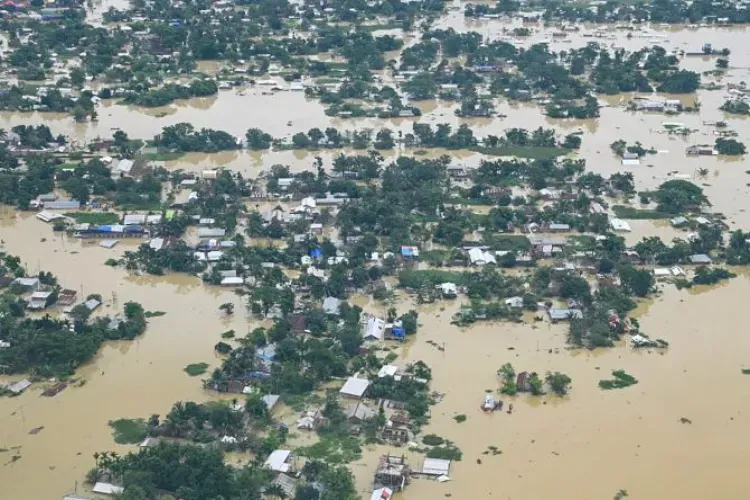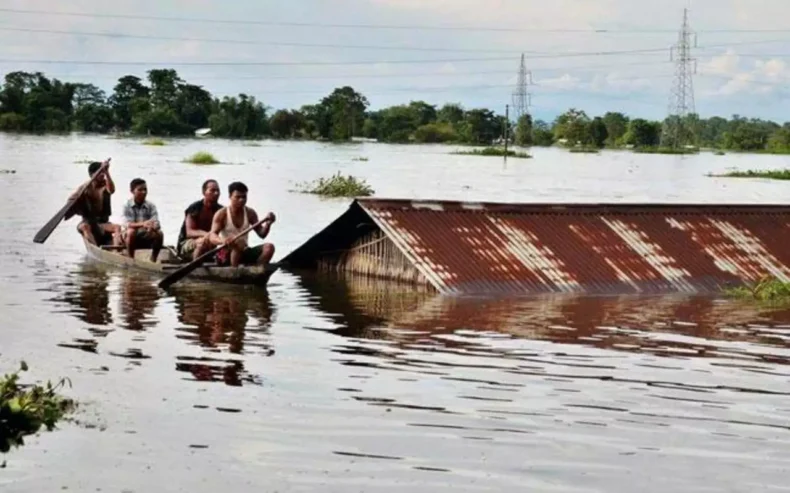Introduction:
Assam, known for its beautiful landscapes and fertile plains, is facing a severe crisis as devastating floods continue to wreak havoc in the state. With over 67,000 people affected across 17 districts, the situation has worsened after neighboring Bhutan released water from its reservoirs. This article sheds light on the grim flood situation in Assam, the impact on the lives of the affected people, and the ongoing efforts to mitigate the damage caused by the relentless deluge.
Unprecedented Flooding in Assam:
Assam, located in northeastern India, is prone to annual monsoon floods due to heavy rainfall and its complex river system. However, this year’s floods have been particularly severe, leaving a trail of destruction in their wake. The situation worsened when Bhutan released excess water from its reservoirs, exacerbating the already dire flood situation in Assam.
Impact on Lives and Livelihoods:
The floods have adversely affected the lives of thousands of people in Assam. Villages and towns have been submerged, forcing residents to abandon their homes and seek refuge in relief camps. Crops have been destroyed, resulting in agricultural losses and jeopardizing the livelihoods of farmers. Furthermore, the floods have disrupted essential services such as transportation, healthcare, and education, leaving communities vulnerable and in need of immediate assistance.
Rescue and Relief Operations:
The government, along with various relief agencies and local authorities, has launched extensive rescue and relief operations to provide aid to the affected population. The National Disaster Response Force (NDRF) and State Disaster Response Force (SDRF) teams have been deployed to carry out rescue missions, evacuate stranded individuals, and provide relief supplies to the flood-affected areas. Efforts are also being made to establish temporary shelters, distribute food and clean drinking water, and ensure medical assistance to those in need.

Challenges in Relief Efforts:
The relief operations in Assam face several challenges due to the scale and intensity of the floods. The inundated areas are often remote and difficult to access, hindering the timely delivery of aid. The continuous rainfall poses additional obstacles, making it challenging to reach affected communities and provide essential services. Moreover, the ongoing COVID-19 pandemic adds an extra layer of complexity, requiring authorities to implement necessary health protocols in relief camps and shelters.
Community Resilience and Solidarity:
Amidst the adversity, the spirit of resilience and community solidarity shines through. Local communities, volunteers, and NGOs have come forward to lend a helping hand by providing food, clothing, and other essential items to those affected. The collective efforts of individuals and organizations are crucial in providing relief and support to the flood-affected population.
Long-term Measures and Preparedness:
The recurring nature of floods in Assam necessitates a comprehensive approach towards disaster management and preparedness. The government, along with relevant agencies, must focus on long-term measures such as improving infrastructure, implementing effective flood control mechanisms, and enhancing early warning systems. Investing in resilient infrastructure and promoting sustainable development practices can help mitigate the impact of future floods.
International Cooperation and Support:
Given the transboundary nature of rivers in the region, cooperation between neighboring countries becomes essential in managing flood situations effectively. India and Bhutan, in particular, need to collaborate and coordinate their efforts to minimize the impact of water releases on downstream areas. International support and assistance can also play a significant role in strengthening disaster management capabilities and enhancing the resilience of flood-prone regions.
Conclusion:
As Assam battles the devastating floods, the affected communities continue to endure hardships and face the daunting task of rebuilding their lives. The situation calls for collective action, with governments, relief agencies, and individuals working together to provide immediate relief, restore normalcy, and strengthen long-term resilience. By implementing comprehensive flood management strategies and fostering international cooperation, we can mitigate the impact of floods and protect the lives and livelihoods of those living in flood-prone regions like Assam.













